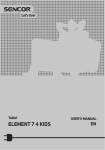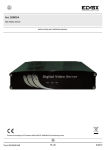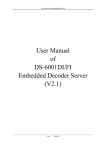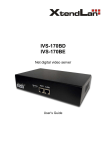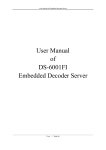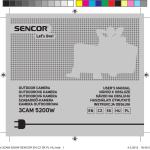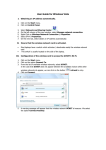Download DS-6000HCI User Manual
Transcript
User Manual of Embedded Net DVS User Manual of DS-6000HCI Series Net Video Server (V1.6) Page 1 Total 34 User Manual of Embedded Net DVS Index VERSION DESCRIPTION ................................................................................................................................. 4 CHAPTER 1 INTRODUCTION ................................................................................................................... 6 1.1 DS-6000HCI FUNCTIONS AND FEATURES.................................................................................................... 6 1.2 COMMON APPLICATION ............................................................................................................................... 7 CHAPTER 2 INSTALLATION ..................................................................................................................... 8 2.1 HARDWARE INSTALLATION ......................................................................................................................... 8 2.1.1 Installation steps................................................................................................................................ 8 2.1.2 Installation notice .............................................................................................................................. 8 2.2 PANEL DESCRIPTION .................................................................................................................................... 8 2.3 THE PIN DEFINITION OF PHYSICS INTERFACES ............................................................................................. 9 2.3.1 PIN definition of RS-232 serial interface........................................................................................... 9 2.3.2 PIN definition of RS485 serial interface .......................................................................................... 11 2.3.3 PIN definition of Ethernet interface................................................................................................. 11 CHAPTER 3 VIDEO SERVER SETUP ..................................................................................................... 13 3.1 PARAMETER SETUP THROUGH RS-232 SERIAL PORT ................................................................................. 13 3.1.1 Hyper Terminal Setup ...................................................................................................................... 13 3.1.2 Shell Commands Under Hyper Terminal ......................................................................................... 16 3.2 THROUGH TELNET TO MODIFY IP ADDRESS ............................................................................................ 18 3.3 PTZ CONTROL .......................................................................................................................................... 23 3.4 CONFIGURE PARAMETERS THROUGH CLIENT-END SOFTWARE.................................................................... 24 CHAPTER 4 UPGRADE FIRMWARE...................................................................................................... 25 4.1 USE SHELL COMMAND AND FTP SERVER ................................................................................................. 25 4.2 USE CLIENT SOFTWARE TO UPGRADE FIRMWARE ...................................................................................... 27 CHAPTER 5 PPPOE DIALUP OPERATION ........................................................................................... 28 5.1 USING PPPOE TO ESTABLISH CONNECTION ............................................................................................... 28 5.2 CLIENT ACCESS DVS WHEN USING PPPOE ............................................................................................... 29 CHAPTER 6 FREQUENT ASK QUESTIONS.......................................................................................... 31 APPENDIX A DS-6000HCI SPECIFICATIONS......................................................................................... 32 APPENDIX B GOOD LIST........................................................................................................................... 33 APPENDIX C CUSTOMER INFORMATION CARD ............................................................................... 34 Page 2 Total 34 User Manual of Embedded Net DVS Thanks for purchase the products of our company. If you have any request or questions, please contact us immediately. This manual is applicable for DS-6000HCI Series Video Server This manual may contain some technically incorrect places or printing errors. This manual will be updated on a regular basis without additional specific notice. The updates will be added into the new version of this manual. We will readily improve or update the products or procedures described in the manual. -3- User Manual of Embedded Net DVS Version Description Version 1.6: 1. solve the problem of the PPP dual-up function 2. solve the problem of NIC do not work in the 10M Full-Dup mode. 3. support signal P frame and replace the B frame with P frame. And the latency of the software decoding at 2CIF,3MBPS and 25FPS is 200ms. Version1.5: Version1.5 firmware of DS-6000HCI series DVS has the following features: 1. Codec update. Specially improve 4CIF compression video quality. Please update “PlayM4.dll” file for client software. -4- User Manual of Embedded Net DVS Version1.4: Version1.4 firmware of DS-6000HCI series DVS has the following new features: 1. Support dual streams. One is called “Main Stream”, and the other is called “Sub Stream”. You can use client software to remote setup main stream and sub stream parameters. Please refer to client software user manual. 2. For old version firmware, if you change the video resolution, the OSD size will be also changed. For version1.4 firmware, OSD size is the same for different resolution. 3. Http port can be modified. Please refer to section 3.3 for remote setup parameters of DVS. 4. Old version firmware can only setup one private mask area. Version1.4 firmware can support setup 4 different private mask areas. -5- User Manual of Embedded Net DVS Chapter 1 Introduction DS-6000HCI series video server adopts embedded real-time multi-task operation system (RTOS) and embedded processor, which is completely independent of PC platform and, efficiently improves system performance. Firmware is burned in FLASH, makes the system more steady and reliable. DS-6000HCI series video server has the function to compress the video signal and audio signal simultaneously into H.264 hardware compression standard; to transmit the compression bitrate through network; to real-time video and audio preview; to support stream protocol (RTP/RTCP, RTSP); to support IE browser, bi-directional voice communication and support multilingual etc. Notes: DS-6001HCI: One channel. The channel can max support 4CIF resolution. DS-6004HCI: Four channels. The 1st channel can max support 4CIF resolution and the 2nd, 3rd, and 4th channels can max support CIF resolution. Or the first two channels can be set as 4CIF resolution, while the 3rd and 4th channels can not work. If you set the channel as 4CIF resolution, please set the bitrate as 1Mbps above to get excellent image quality. 1.1 ¾ DS-6000HCI functions and features Basic Function: 1. 2. 3. High speed & high compression ratio of H.264 video hardware real-time compression; Multiple security level leads to high system safety; Support one RS-485 interface that can be used to control pan-tilt-zoom and translucent channel input; ¾ Compression Function 1. Support one or four Channels of video (PAL/NTSC) signal, and can be real-time hardware compressed in 25F/S (PAL) or 30F/S (NTSC) CIF resolutions independently. Video is compressed using H.264 standard, and it supports not only variable bitrate but also variable frame rate. When choosing video image quality, you can also limit the bitrate of the compression code. ¾ 2. 3. Support 4CIF, DCIF, 2CIF, CIF, QCIF resolution. Support OSD the position of the date and time can be adjusted, date and time can be added automatically. 4. Support LOGO, the position of it can be anywhere in the video image. Network Function 1. 2. Support one 10M/100M Ethernet compatible interface; Support TCP/IP protocol; Parameter setting, real-time video & audio previewing, status -6- User Manual of Embedded Net DVS examination, alarm through network and store the compression bitrate through network. 3. 4. 5. Support pan-tilt-zoom control such as the turn of PTZ, iris and focus; Support remote upgrading and maintenance; RS-485 interfaces support transparent transmission mode, and remote hosts can control serial devices through it; 1.2 Common application Network digital surveillance, such as ATM machine, factory and the bank etc.; Remote monitoring service for prison, nursery and school; Intelligent gate system (dynamic record the people in and out); Intelligent building and community; Uncared-for system of electric power station or telecom base station; Outdoor equipment monitoring; Bridge, tunnel and cross road-monitoring system; Pipeline, warehouse monitoring; 24 hour monitoring of traffic; Remote monitoring of forest, water and river etc. -7- User Manual of Embedded Net DVS Chapter 2 Installation 2.1 Hardware installation 2.1.1 Installation steps 1. 2. 3. Open packing case, and check the integrity; Take out things needed in installation; Connect cables needed (video signal input cable, audio signal input cable, RS485 cable and cable for LAN); 4. Take out stabilizer power supply and power on. 2.1.2 Installation notice Please read the following notice carefully. If you have any question, please contact us. Notice: 1. After Opening the packing box, please check carefully to confirm that the goods in it are consistent with list; 2. 3. 4. 5. Please read user's manual carefully before installation; Please power-off all related equipments before installation; Please check the voltage of power supply to avoid voltage mismatch; Installation environmental: Do not use it under humidity and high temperature; to keep ventilation to vent freely, avoid to be walled up; to keep them horizontally, avoid to set up in the vibration surroundings. 2.2 Panel description Front panels: Interface Instruction (From left to right in turn) 1. Tx/Rx indicator lamp; 2. Link indicator lamp; -8- User Manual of Embedded Net DVS 3. Power supply indicator lamp; Back panel(DS-6004HCI): Interface Instruction(From left to Right in return): 1. Power jack is connected with 5V direct current through voltage stabilizer; Please use the stabilizer power supply correctly; 2. UTP network connector; 3. 4 external alarm input and 2 relay output; 4. Standard RS-485 serial port RJ45 socket and Standard RS-232 serial port RJ45 socket; 5. 4 channels video input and audio input; 6. One line in audio input 7. One audio output. 2.3 The pin definition of physics interfaces 2.3.1 PIN definition of RS-232 serial interface The DVS has one RS232 standard serial interface, with RJ-45 connector. Its pin definition is as follows (‘I’ means input, and ‘O’ means output): (1) When the RS232 interface of the DVS connects with the DTE equipment, one end of the cable is the 8-pin RJ45 connector (to DVS) and -9- User Manual of Embedded Net DVS the other of the cable is the DB25 female connector (to DTE). Below is the description of the internal connection between RJ45 and DB25. (2) 25-pin to 9-pin converter’s internal connection is like this: (3) If you don’t want to use 25-pin to 9-pin convertor to connect DVS and DTE through RS232 interface, you must use RJ45-DB9 cable. Its internal connection description is: - 10 - User Manual of Embedded Net DVS (4) When the RS232 interface of the DVS connects with the DCE (such as MODEM), one end of the cable is the 8-pin RJ45 connector and the other is the DB25 male connector. Below is the description of the internal connection between RJ45 and DB25: 2.3.2 PIN definition of RS485 serial interface 2.3.3 PIN definition of Ethernet interface (1) PIN definition of the direct network cable connecting DVS and - 11 - User Manual of Embedded Net DVS HUB: (2) PIN definition of the cross network cable connecting DVS and host PC: - 12 - User Manual of Embedded Net DVS Chapter 3 Video Server Setup There are three kinds of methods to configure the parameters of video server. 1. Through Hyper Terminal (connect DVS with the PC through RE-232 serial ports) 2. Through TELNET (connect DVS with PC through network) 3. Through client-end application software (connect DVS with PC through network) 3.1 Parameter Setup through RS-232 serial port Mainly set up IP parameters of the video server through serial port. The defaulted IP address is 192.0.0.62. Under the case that the IP address is unknown; the Hyper Terminal (need to connect the serial ports) can only be adopted to configure IP address and other parameters. Under the case that IP address is known, TELNET can be adopted to configure IP address and other parameters, and can also modify the IP address by using client-end software. 3.1.1 Hyper Terminal Setup Please direct connect the RS-232 serial port of PC with the RS-232 serial port of video server before configuration (there are RJ45 head and DB9 line in the packing carton) How to establish the connection with the super terminal connection? Step one: Enter into Hyper Terminal. Click “Start” Æ “Programs” Æ “Accessories” Æ “Communications” Æ “Hyper Terminal” in Windows system, and the dialogue box below will appear (Fig. 3.1.1): - 13 - User Manual of Embedded Net DVS Fig. 3.1.1 newly establish a connection and define the name and icon Step2: To name the connection name and to define the icon. Input a name (e.g. aa), select a icon, press “OK”, the dialogue box like Fig. 3.1.2 appears. Fig. 3.1.2 select communication port Step 3”: to select the communication port. Select “com1” communication port in Fig3.1.2, press “OK”, the dialogue box as Fig. 3.1.3 will appear. Fig. 3.1.3 Serial ports parameter setup Step 4: Serial port parameters setup. Set the serial port parameters as the following setup: Bits per second: 115200, Data bits: 8, Parity: None, Stop bits: 1, Flow control: None. Press “OK” after - 14 - User Manual of Embedded Net DVS finish, the Hyper Terminal interface like Fig. 3.1.4 will appear Fig. 3.1.4 Hyper Terminal Interface Step 5: To close the window, the Fig. 3.1.5 will appear. Select “Yes” and Fig. 3.1.5 will appear. Select “Yes” again to have the Fig. 3.1.6 Fig. 3.1.5 to disconnect Fig. 3.1.6 save Hyper Terminal session Step 6: Save the Hyper Terminal session for using next time. After saving, it will new establish a “Hyper Terminal” item in the program group “Start” Æ “Programs”Æ “Accessories”Æ “Communications” Æ “Hyper Terminal” and it includes all “Connection” name for all Hyper Terminal. Here you have see a “aa.ht”. - 15 - User Manual of Embedded Net DVS 3.1.2 Shell Commands Under Hyper Terminal Please use the DTE cable and the DB9/DB25 convertor to connect PC with DVS RS-232 port. Step 1: Enter into the Hyper Terminal. Click “ Start”Æ “Programs”Æ “Accessories”Æ “Communications”Æ “Hyper Terminal”Æ “aa.ht”, the Hyper Terminal interface in Fig, 3.1.4 will appear. Step 2: Press “Enter” in Hyper Terminal, the prompt “—>” appear, as in Fig. 3.1.7. Under this prompt the following operation commands to accomplish the setup of the parameters. Fig. 3.1.7 Hyper Terminal command prompt Input help, the supported configuration commands can be checked up, as in Fig. 3.1.8. Fig. 3.1.8 to check command The following is the introduction of getIp, setIp commands. - 16 - User Manual of Embedded Net DVS getIp Function:to get the fixed IP, subnet mask, gateway, command port, IP address of PPPoE dialup (the IP address of PPPoE will be 0.0.0.0 if there is no dialup or dialup is not successful). Parameter: none. Grammar format: Enter after input the command Explanation: Please pay attention whether the inputting letters are capital or low case. Fig. 3.1.9 to get parameters of IP, PPPoE setIp Function:to set the IP, subnet mask and gateway of the device Parameter:IP address, subnet mask, gateway Grammar format:setIp IP: mask Explanation: Please pay attention whether the inputting letters are capital or low case. And separate the parameters by colons. Fig. 3.1.10 to set IP - 17 - User Manual of Embedded Net DVS 3.2 Through TELNET to modify IP address Please confirm PC and the video server are well established the network connection and can connect video server through PING before configuration. There are two following manners: (Fig.3.1.12, Fig. 3.1.13). HUB/SWITCH PC Video Server Fig. 3.1.12 through direct network cable to connect PC Video Server Fig. 3.1.13 through cross network cable to connect How to enter into TELNET interface? Step 1: Click “Start” and “RUN” in WINGDOWS, the dialogue box like Fig. 3.1.14 will appear: - 18 - User Manual of Embedded Net DVS Fig. 3.1.14 Enter into command Step 2: Input “cmd” in the dialogue box as Fig. 3.1.14 to enter into command window. Fig. 3.1.15 Enter into TELNET command line Step 3: Input “telnet” when the prompt appeared <video server> <Enter>, the system is establishing the connection between PC and Video Server. Fig. 3.1.16 establish the connection between PC and Video Server Step 4: If the connection is failed, please check whether RJ45 connector is well connected, or check the network. If it is successfully connected, the login prompt “NetDVRDVS:” appears. Input user’s name “root” under the prompt and press “ENTER” as in Fig.3.1.17 - 19 - User Manual of Embedded Net DVS Fig. 3.1.17 Input the user’s name of TELNET operation Step 5: input the password in “Password” appeared: password, and press “Enter”. If there is no “Password” appears, please contact your provider. Fig. 3.1.18 Input TELNET command Step 6: At this time, the prompt of TELNET command“Æ” is shown. It indicates it has entered into TELNET interface, all the TELNET command can be input and set. If the prompt of TELNET command “Æ”is not shown, please contact your provider. Explanation of TELNET command (Note: Please pay attention to capital or low-case letters in the command format) Input help in TELNET prompt, the configuration command supported by TELNET can be checked, including getIp, setIp, exit etc, please refer to fig. 3.1.19. - 20 - User Manual of Embedded Net DVS Fig. 3.1.19 TELNET command collection getIp Function: to get the fixed IP, subnet mask, gateway, password on the command end, PPPoE dialup IP (when there is not dialup, or dialup is not successful, the IP shown is: 0.0.0.0) Parameter: none Grammar format: input the command and press “Enter” directly Explanation: Please pay attention whether the inputting letters are capital or low case. setIp Function: to set the fixed IP, subnet and gateway of the unit Parameters: the fixed IP address, subnet and gateway of the unit Grammar format: setIp IP: mask: gateway Explanation: Please pay attention whether the inputting letters are capital or low case, and separate the parameters by colon. - 21 - User Manual of Embedded Net DVS - 22 - User Manual of Embedded Net DVS 3.3 PTZ control Step1: Connect DS-6000HCI RS-485 interface with PTZ. Please refer to RS-485 pin definition. DVS just uses Pin1 (TX+) and Pin2 (TX-) to send PTZ control command. Step2: You can use remote client software to setup PTZ protocol. In client software remote setup dialog box, select “Serial Para” tab button. You can select DVS PTZ parameters in the corresponding dialog box. Please refer to client software user manual for detail information. - 23 - User Manual of Embedded Net DVS 3.4 Configure parameters through client-end software Before the configuration, please make sure that the PC and the video server has been established the network connection, you can confirm using PING command. Please refer to the user manual of DVRDVS client software for detail information. - 24 - User Manual of Embedded Net DVS Chapter 4 Upgrade Firmware There are two methods to upgrade the DVS firmware. One is using shell commands to ask DVS to download firmware from FTP server. The other is using PC client software. 4.1 Use Shell Command and FTP Server 1. Using DTE cable to connect the RS232 of DVR to the RS232 of PC. 2. Setup the Hyper Terminal correctly and run it. 3. Make sure the FTP Server (wftpd32.exe) is setup correctly (the corresponding user manual is in CD) and run it. 4. Make sure the network between DVRDVS and PC is ok. 5. Press "ctrl" and "u" keys of the PC keyboard, do not release them. 6. Switch off and on the power supply of DVRDVS. 7. In the HyperTerminal, the following sentence is appeared: Please input [u/U] or [ESC] key 8. Release "ctrl" and "u" keys, press "u" key 9. After that, please refer to following pictures. In the example, I set the DVRDVS as "192.0.0.95" and ftp server as "192.0.0.144". Of course the ftp server software (wftpd32.exe) is run in the PC whose ip address is "192.0.0.144" and the network is OK. In this case, DVRDVS (192.0.0.95) will search the PC(192.0.0.144) and download - 25 - User Manual of Embedded Net DVS the firmware from ftp server. - 26 - User Manual of Embedded Net DVS 4.2 Use Client Software to upgrade firmware In the system setup dialog of DVRDVS client software (refer to client software user manual), there is a button named “Upgrade”: Select the DVRDVS, Click “Upgrade” button, the following dialog box will be appeared: Fig.4.21 remote upgrading Click “Browse” button and select the firmware file. Then click “Upgrade” button, to complete the upgrading process of the video server firmware. - 27 - User Manual of Embedded Net DVS Chapter 5 PPPoE dialup operation DS-6000HCI video server supports remote access through network, through browser, through PPPoE or PPP dialup. Before using this function, please make sure that the software you used in your device support such functions or not. 5.1 Using PPPoE to establish connection In the local LAN, use the client software remote setup the DVS parameters. The setup dialog is looked as following: In the server parameters sub dialog, enable PPPoE function, input the correct PPPoE user name and PPPoE password. Click “OK” button and “Save Para.” button. The new server parameters will be save into video server through network. Reboot the video server, the DVS will start to dialup the internet.After success, the video server will get a dynamic WAN IP address. - 28 - User Manual of Embedded Net DVS [Explanation] please make sure that ADSL Modem is installed. If it is the first time to set PPPoE parameters, it needs to reboot video server to establish the connection. 5.2 Client access DVS when using PPPoE There are two methods: One is to access using the current WAN IP address of the video server. When the video server is successful establish the network connection by using PPPoE mode, it will get the WAN IP address. You can use Hyper Terminal to get the WAN IP address, and access this IP address through client software. The other is to access through domain analysis server. By using this mode, you need a PC with a fixed WAN IP address in the Internet, and there is the domain analysis server software running in this PC (actually this PC is the analysis server). We provide such demo DNS software and SDK. In the server parameters of video server, there is an item named DNS. Please input the PC fixed WAN IP address here. When the video server is successfully connection with the internet by using PPPoE, it will get a dynamic WAN IP address, and send the name and current IP address to the analysis server. If the client-end software wants to access the video server, it’d first to - 29 - User Manual of Embedded Net DVS connect with the PC used as the analysis server, telling the analysis server which one video server he wants to access. The analysis server will search all the video servers have been registered, find out the server with the same name or same serial number, and tell the client-end the WAN IP address of the video server. After the client-end software get the current IP address, it can establish the network connection with the video server to get the video images directly. Here the fixed WAN IP address of PC is 220.184.114.48. We call it as DNS IP. In that the PC, a demo analysis server software named IPServer is run. It can get the video server information, including the dynamic WAN IP address of the video server. - 30 - User Manual of Embedded Net DVS Chapter 6 Frequent ask questions 1, Failure to control PTZ It is possible that the camera and equipment are not connected through RS485 port, or the wrong configuration of the decoder. 2,certain individual channel picture is un-normal Please check whether the video cable is well connected with the camera and the Embedded DVS 3,Possible reasons which can cause the failure of upgrading Failure of the network, IP address error in the FTP host computer, FTP service is not been booted by PC, the path to upgrade is incorrect, no permission (usually happened when to upgrade through client-end.) If the above information cannot meet your demand, please not hesitate to contact the provider. - 31 - User Manual of Embedded Net DVS Appendix A DS-6000HCI Specifications DS-6001HCI Compression H.264 Video Standard Playback Resolution Ratio Video Input Video Frame Rate DS-6004HCI 4CIF, DCIF, 2CIF, CIF, QCIF 1 Channel 4 Channels PAL: 25 Frame/Second NTSC: 30 Frame/Second Code Stream Can Select Single Video Stream or Composite Stream, 32Kbps~2Mbps and self-defined Audio Input 1 Channel 4 Channels Audio Output Dimensional Sound earphone jack Audio Compression OggVorbis Standard Audio Compression Code 16Kbps Rate Voice Audio Input(MIC) Linear Audio Input Communication interface 1 RJ45 10M/100M Self-adaptable Ethernet Interface 1 RS232 interface 1 RS 485 interface for PTZ Alarm in 4 ports Alarm out 2 ports Power Supply DC 5V Power Consumption Less than 7W Working Temperature -10℃--+55℃ Working Humidity 10%-90% Size 198mm*123mm*39mm Weight 1.0 Kg Stabilizer power suppler: input AC 100-240V47-63Hz - 32 - User Manual of Embedded Net DVS Appendix B Good list 1. One piece of DS- 6000HCI video server; 2. A CD contains client application; 3. One power supply voltage stabilizer 4. A 220V power cable; 5. A cable connecting RS232 with DTE; - 33 - User Manual of Embedded Net DVS Appendix C Customer Information Card User’s Name Company Name Post Address Postcode Phone Number E-mail Model Number of Product Serial Number of Product Purchase Date Distributor Suggestions: Mr./Mrs. - 34 -



































